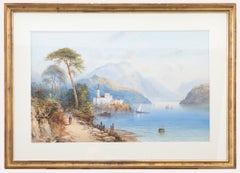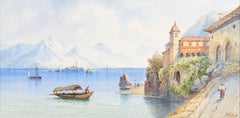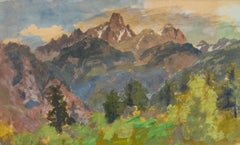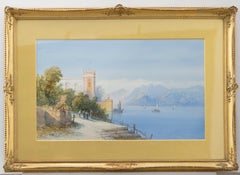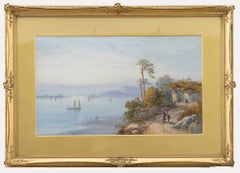Frank Catano Art
to
1
1
1
Overall Width
to
Overall Height
to
1
1
1
2
1
1
1
1
1
1
2
2
1
1
2
8,232
2,807
1,650
1,318
1
1
1
Artist: Frank Catano
Attrib. Frank Catano (1880-1920) - Watercolour, Italian Lake Scene with Figures
By Frank Catano
Located in Corsham, GB
A fine watercolour painting of an Italian lakeside with scots pines in the foreground and a large castle dwelling behind. The painting has been carefully heightened with body colour ...
Category
Late 19th Century Frank Catano Art
Materials
Watercolor
'View of Lake Como', Northern Italian Landscape
By Frank Catano
Located in Santa Cruz, CA
A delicate gouache landscape showing a view of a Renaissance villa overlooking calm blue waters of Lake Como, Italy.
Signed lower right, 'F. Catano', (Italian, 19th century); inscri...
Category
1980s Realist Frank Catano Art
Materials
Paper, Gouache
Related Items
19th C. American Impressionist Gouache of Colorado Mountains in Spring
By Charles Partridge Adams
Located in Denver, CO
This original circa 1910s plein air field study by renowned Colorado landscape artist Charles Partridge Adams captures the serene beauty of the Rocky Mountains in a masterful display...
Category
1910s American Impressionist Frank Catano Art
Materials
Gouache
$1,250
H 13.75 in W 17.75 in D 0.75 in
Wash Day, Coastal Stream
By Jules Noel
Located in Greenville, DE
Signed lower right dated 1875.
Category
1870s Realist Frank Catano Art
Materials
Watercolor, Gouache
A peaceful forest with sunlight filtering through tall trees onto mossy ground
Located in Preston, GB
A peaceful forest with sunlight filtering through tall trees onto mossy ground. A signed unique original by 20th Century British/Australian Artist, Vernon Keeble (1951-2018)
Art mea...
Category
1990s Realist Frank Catano Art
Materials
Paper, Watercolor, Gouache, Board
$1,413 Sale Price
30% Off
H 28 in W 34 in D 1 in
Paris : Winter Day at Montmartre - Original signed gouache painting - Cerificate
By Maurice Utrillo
Located in Paris, IDF
Maurice UTRILLO
Paris : Winter Day at Montmartre
Original gouache painting
Signed bottom right
40 x 32 cm at view (c. 16 x 13")
Painted c. 1934-36
Presented in a golden wood frame ...
Category
1930s Realist Frank Catano Art
Materials
Gouache, Paper
$90,106
H 15.75 in W 12.6 in
Early Twentieth Century Aviation Vintage Aircraft Airplane Framed Painting
Located in ludlow, GB
Early Twentieth Century Aviation Vintage Aircraft Airplane Framed Gouache Painting of Imperial Airways Hannibal. One of a set of three that were painted by the well known Artist and Illustrator Charles Thomas Howard. Each was painted to be published as postcards so these are the original artworks. They are in good clean condition with fresh and vibrant colours I have had them framed in handmade gold frames with a flecked cream mount.
Can be sold individually or as a set, they look really striking displayed together.
“Three Studies of Airplanes”
Gouache, Signed and Framed.
Charles Thomas Howard was born in Boston, Lincolnshire in 1865 and after he married in 1905 moved to London where he pursued his career as Painter and Illustrator. He did many works that were produced as postcards as these three all were. He worked for at least three publishers and was incredibly highly sought after. His work was diverse but he specialised in Aviation, Railways and Military subjects.
His work is held in many Art Libraries including the Bridgeman and as postcards have been reprinted many times over the years and still resonate with todays audiences.
He died at the age of 76 in West Sussex.
These originals comprise of De Havilland Comet...
Category
Early 20th Century Realist Frank Catano Art
Materials
Gouache
$1,253
H 12 in W 15.5 in D 1 in
Rare Hand Colored "Cabane Des Hold" - 1st Ed "Description de l’Univers" C. 1683
By Alain Manesson Mallet
Located in Soquel, CA
Rare Engraving "Cabane Des Hold, Terres Artiques, Fig CII," 1st edition "Description de l’Univers, page 281
This rare image depicts the Willem Barentsz expedition of 1597 to Novaya Zemlya, Russia. The engraving, with later hand-coloring, shows the cabin and ship of the Dutch arctic expedition of Barentsz on Novaya Zemlya (Nova Zembla), with the party being attacked (and in some cases apparently eaten) by bears and wolves. Dutch explorer, Willem Barentsz, reached the west coast of Novaya Zemlya in 1594, and in a subsequent expedition of 1596 rounded the northern point and wintered on the northeast coast. Barentsz died during the expedition, and may have been buried on the northern island.
This artwork is a page from a book by 17th century cartographer and engineer, Allain Manesson Mallet (French, 1630-1706), "Description de L'Univers, contenant les differents systêmes du monde, les cartes générals et particulières de la géographie ancienne et modern." Paris: Denys Thierry, 1683.
Presented in an cream colored mat.
Text on verso shown in images.
Mat Size: 11.5"H x 9.07"W
Paper Size: 8.25"H x 5.44"W
Image Size: 5.63"H x 3.75"W
Alain Manesson Mallet (French, 1630-1706) was a 17th century cartographer and military engineer. He started his career as a musketeer in the army of Louis XIV, became a Sergeant-Major in the artillery and an Inspector of Fortifications. He later served under Alfonso VI, King of Portugal...
Category
1680s Realist Frank Catano Art
Materials
Paper, Ink, Gouache
$380 Sale Price
20% Off
H 11.5 in W 9.07 in D 0.07 in
Early Twentieth Century Aviation Vintage Aircraft Airplane Framed Paintings
Located in ludlow, GB
Early twentieth Century Aviation Vintage Aircraft Airplane Gouache Framed Paintings by renowned Artist and Illustrator Charles Thomas Howard. Each of these three were painted to be published as postcards, these are the original artworks. They are in good clean condition with fresh and vibrant colours and I have framed them in handmade gold frames with a flecked cream mount.
This is the De Havilland Comet...
Category
Early 20th Century Realist Frank Catano Art
Materials
Gouache
$1,253
H 12 in W 15.5 in D 1 in
Early Twentieth Century Aviation Vintage Aircraft Airplane Framed Paintings
Located in ludlow, GB
Early Twentieth Century Aviation Vintage Aircraft Airplane Framed Gouache Paintings.
Three paintings by the well known Artist and Illustrator Charles Thomas Howard they were each painted to be published as postcards, so these are the original artworks. They are in good clean condition with fresh and vibrant colours, I have framed them in handmade gold frames with a flecked cream mount. They can be purchased individually or as a set, they do look striking displayed as a group. This is the Miles Sultan aircraft.
“Three Studies of Airplanes”
Gouache, Signed and Framed.
Charles Thomas Howard was born in Boston, Lincolnshire in 1865 and after he married in 1905 moved to London where he pursued his career as Painter and Illustrator. He did many works that were produced as postcards as these three all were. He worked for at least three publishers and was incredibly highly sought after. His work was diverse but he specialised in Aviation, Railways and Military subjects.
His work is held in many Art Libraries including the Bridgeman and as postcards have been reprinted many times over the years and still resonate with todays audiences.
He died at the age of 76 in West Sussex.
These originals comprise of De Havilland Comet...
Category
Early 20th Century Realist Frank Catano Art
Materials
Gouache
$1,253
H 12 in W 15.5 in D 1 in
View Of The City
Located in Lake Worth Beach, FL
Early 20th Century European School, view of the city, with buildings in the background, gouache on paper unsigned in a beautiful custom made Haydenryk frame under glass.
Category
Early 20th Century Realist Frank Catano Art
Materials
Gouache, Board
Siebe Johannes Ten Cate (1858-1908) View of Toledo, 1896, watercolor signed
By Siebe Johannes Ten Cate
Located in Paris, FR
Siebe Johannes Ten Cate (1858-1908)
A View of Toledo
Signed, located and dated lower left
Watercolor on paper
35.5 x 55 cm irregularly shaped
in good condition, some foxings in the ...
Category
1890s Impressionist Frank Catano Art
Materials
Watercolor
$1,621
H 13.98 in W 21.66 in
Sun's Rays, Westhampton Beach
By John Button
Located in New York, NY
Gouache on paper
Signed and dated, l.r.
9 x 12 inches
This artwork is offered by ClampArt, located in New York City
Born in California, John Button (1929-1982) was educated at Univ...
Category
1970s Realist Frank Catano Art
Materials
Gouache, Paper
Ford Plant, Dearborn, Michigan
By John Button
Located in New York, NY
Gouache on paper
Signed and dated, l.l.
This artwork is offered by ClampArt, located in New York City
Born in California, John Button (1929-1982) was educated at University of Cali...
Category
1970s Realist Frank Catano Art
Materials
Gouache, Paper
Previously Available Items
Frank Catano (fl.1880-1920) - Framed Watercolour, Italian Lake Scene
By Frank Catano
Located in Corsham, GB
A fine late 19th/early 20th century watercolour scene by Frank Catano (fl.1880-1920). The scene depicts a picturesque Italian lake with figures walking before a tall medieval wall wi...
Category
Late 19th Century Frank Catano Art
Materials
Watercolor
Frank Catano (fl.1880-1920) - Framed Late 19th Century Watercolour, Italian Bay
By Frank Catano
Located in Corsham, GB
A fine late 19th/early 20th century watercolour scene by Frank Catano (fl.1880-1920). The scene depicts a picturesque Italian bay with figures walking the coastal path. The artist ha...
Category
Late 19th Century Frank Catano Art
Materials
Watercolor
Frank Catano (fl.1880-1920) - Framed Watercolour, Cairo City Market
By Frank Catano
Located in Corsham, GB
A fine watercolour scene by Italian artist Frank Catano (fl.1880-1920), depicting the bustling streets of Cairo with a grand mosque in the background. Signed to the lower left-hand c...
Category
Late 19th Century Frank Catano Art
Materials
Watercolor
Frank Catano (fl.1880-1920) - Framed Watercolour, Streets of Cairo
By Frank Catano
Located in Corsham, GB
A fine watercolour scene of the streets of Cairo with body colour by Frank Catano (fl.1880-1920). Well presented in contemporary gilt frame with fluted cove and blue velvet slip. Sig...
Category
Late 19th Century Frank Catano Art
Materials
Watercolor
Frank Catano art for sale on 1stDibs.
Find a wide variety of authentic Frank Catano art available for sale on 1stDibs. You can also browse by medium to find art by Frank Catano in paint, watercolor, gouache and more. Not every interior allows for large Frank Catano art, so small editions measuring 20 inches across are available. Customers who are interested in this artist might also find the work of John Fulleylove, James March Phillips, and Hubert Hennes. Frank Catano art prices can differ depending upon medium, time period and other attributes. On 1stDibs, the price for these items starts at $475 and tops out at $2,250, while the average work can sell for $542.
